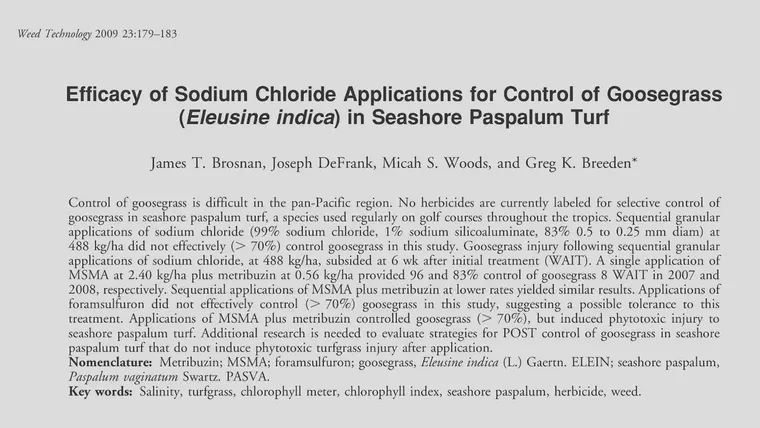Can sodium chloride control weeds in seashore paspalum turf?
One of the challenges in managing seashore paspalum (Paspalum vaginatum) turf is weed control. There are not many herbicides that can be used without damaging seashore paspalum.
I worked with Dr. James Brosnan on a project to investigate sodium chloride (NaCl, or table salt) applications for control of weeds in seashore paspalum turf. Our article, Efficacy of Sodium Chloride Applications for Control of Goosegrass (Eleusine indica) in Seashore Paspalum Turf, was published in Weed Technology.

Because seashore paspalum has a high salinity tolerance, it may be able to tolerate salt applications that would be toxic to weeds. In our study, we looked at sodium chloride application rates of 49 g m-2 (10 lbs/1000 ft2), applied every seven days for three consecutive weeks.
This rate of sodium chloride application did not damage the seashore paspalum, but it also did not provide effective control of goosegrass; the sodium chloride applications resulted in slightly more than 50% control of the goosegrass eight weeks after treatment. The published study was conducted in Hawaii, and the treatment that provided the best control of goosegrass was MSMA, but the MSMA applications caused phytotoxicity on the seashore paspalum.
Another experiment was done to look at control of Paspalum conjugatum (some common names for this plant are sourgrass, carabaograss, or hilograss) in seashore paspalum turf. Our article about this experiment was also published in Weed Technology, and we found that there was effective control of the weedy grass with the same application rates of sodium chloride (sequential applications of granular sodium chloride at 49 g m-2).